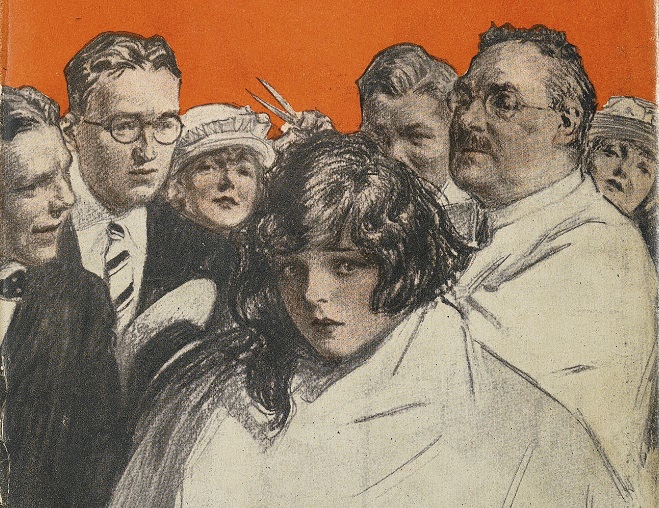From American Fantastic Tales: Terror and the Uncanny from Poe to the Pulps
Interesting Links
“Why I Wrote The Yellow Wallpaper,” Charlotte Perkins Gilman (The American Yawp Reader)
“What’s Behind Charlotte Perkins Gilman’s Yellow Wallpaper?” (Ms. Magazine)
“Go rest, young man”: Silas Weir Mitchell and the “West cure” (American Psychological Association)
Previous Story of the Week selections
• “A Respectable Woman,” Kate Chopin
• “The Shell of Sense,”
Olivia Howard Dunbar
• “Tom’s Husband,” Sarah Orne Jewett
• “The Little Room,”
Madeline Yale Wynne
Buy the book
 American Fantastic Tales: Terror and the Uncanny from Poe to the Pulps
American Fantastic Tales: Terror and the Uncanny from Poe to the Pulps
746 pages
“Why I Wrote The Yellow Wallpaper,” Charlotte Perkins Gilman (The American Yawp Reader)
“What’s Behind Charlotte Perkins Gilman’s Yellow Wallpaper?” (Ms. Magazine)
“Go rest, young man”: Silas Weir Mitchell and the “West cure” (American Psychological Association)
Previous Story of the Week selections
• “A Respectable Woman,” Kate Chopin
• “The Shell of Sense,”
Olivia Howard Dunbar
• “Tom’s Husband,” Sarah Orne Jewett
• “The Little Room,”
Madeline Yale Wynne
Buy the book
 American Fantastic Tales: Terror and the Uncanny from Poe to the Pulps
American Fantastic Tales: Terror and the Uncanny from Poe to the Pulps746 pages
 |
| Cover of the 1899 edition of The Yellow Wall Paper.The book version of Gilman’s story was published under her name from her first marriage. |
It is a description of a case of nervous breakdown beginning something as mine did, and treated as Dr. S. Weir Mitchell treated me with what I consider the inevitable result, progressive insanity.Mitchell, immortalized by name in Gilman’s story, was the physician who first developed the famous “rest cure” for women suffering from depression. The regimen included isolation, bed rest, and heavy foods and prohibited work of any kind, physical or intellectual. His male patients who suffered from nervous disorders, however, were treated with the “West cure,” which incorporated outdoor living, physical activity, and male companionship; they were also encouraged to write about their experiences. The authors Virginia Woolf, Edith Wharton, and Jane Addams all underwent the “rest cure,” while Walt Whitman, Owen Wister (The Virginian), and Theodore Roosevelt were among the writers who benefited from Mitchell’s “West cure.”
Gilman sent her manuscript to William Dean Howells in 1890, who tried to place it in The Atlantic Monthly, but the magazine’s current editor declined, saying the story made him feel “miserable.” It was published instead by The New England Monthly in 1892—although she never received payment, having apparently been robbed by an unscrupulous agent.
The story caused a sensation. Gilman quotes one letter-writer who protested to the editors: “[To those] whose lives have become a struggle against an heredity of mental derangement, such literature contains deadly peril.” A Missouri doctor, however, wrote that he was “overwhelmed with the delicacy of your touch and the correctness of portrayal. . . . So far as I know, and I am fairly well up in literature, there has been no detailed account of incipient insanity.” The doctor wondered hesitantly (and as tactfully as possible, considering the nature of the question) if Gilman herself had suffered from such an illness, and she responded, “I had been as far as one could go and get back.”
In 1920, the year he died, Howells included “The Yellow Wall Paper” in The Great Modern American Stories. But for the next fifty years, the story was largely confined to Gothic horror anthologies—until Elaine Hedges published an edition for The Feminist Press in 1973, calling it a “small literary masterpiece.” In recent decades, the story has been ubiquitous in literary anthologies and textbooks and is now widely taught to high school and college students.
Note: Wall Paper or Wall-Paper or Wallpaper? Readers will note that the spelling of the title of Gilman’s most famous work varies from source to source. The story was reprinted several times during Gilman’s life, and the title was printed in any number of ways. The LOA uses the text of the story’s first appearance as a small book, published in 1899 and titled The Yellow Wall Paper.
* * *
It is very seldom that mere ordinary people like John and myself secure ancestral halls for the summer. . . . If you don't see the full selection below, click here (PDF) or click here (Google Docs) to read it—free!This selection may be photocopied and distributed for classroom or educational use.







